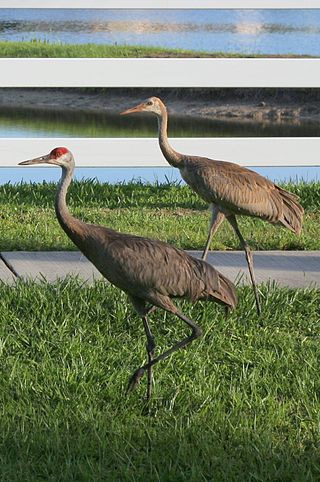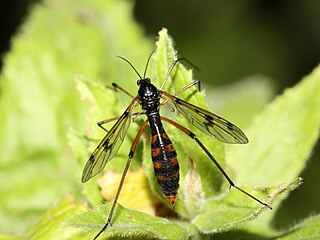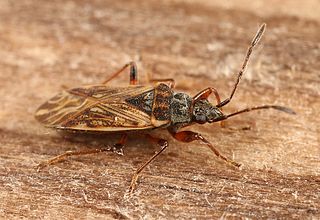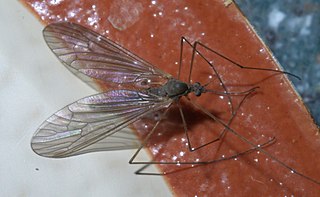
Cranes are a type of large bird with long legs and necks in the biological family Gruidae of the order Gruiformes. The family has 15 species placed in four genera which are Antigone, Balearica, Leucogeranus, and Grus. They are large birds with long necks and legs, a tapering form, and long secondary feathers on the wing that project over the tail. Most species have muted gray or white plumages, marked with black, and red bare patches on the face, but the crowned cranes of the genus Balearica have vibrantly-coloured wings and golden "crowns" of feathers. Cranes fly with their necks extended outwards instead of bent into an S-shape and their long legs outstretched.

A crane fly is any member of the dipteran superfamily Tipuloidea, which contains the living families Cylindrotomidae, Limoniidae, Pediciidae and Tipulidae, as well as several extinct families. "Winter crane flies", members of the family Trichoceridae, are sufficiently different from the typical crane flies of Tipuloidea to be excluded from the superfamily Tipuloidea, and are placed as their sister group within Tipulomorpha.

The sandhill crane is a species of large crane of North America and extreme northeastern Siberia. The common name of this bird refers to their habitat such as the Platte River, on the edge of Nebraska's Sandhills on the American Great Plains. Sandhill cranes are known to frequent the edges of bodies of water. The central Platte River valley in Nebraska is the most important stopover area for the nominotypical subspecies, the great sandhill crane, with up to 450,000 of these birds migrating through annually.

The whooping crane is an endangered crane species, native to North America, named for its "whooping" calls. Along with the sandhill crane, it is one of only two crane species native to North America, and it is also the tallest North American bird species. The whooping crane's lifespan is estimated to be 22–24 years in the wild. After being pushed to the brink of extinction, due to unregulated hunting and loss of habitat, and just 21 wild cranes remaining by 1941, conservation efforts would lead to a partial recovery. The total number of cranes in the surviving migratory population, plus three reintroduced flocks and in-captivity, only slightly exceeds 800 birds as of 2020.

The Siberian crane, also known as the Siberian white crane or the snow crane, is a bird of the family Gruidae, the cranes. They are distinctive among the cranes: adults are nearly all snowy white, except for their black primary feathers that are visible in flight, and with two breeding populations in the Arctic tundra of western and eastern Russia. The eastern populations migrate during winter to China, while the western population winters in Iran and (formerly) in Bharatpur, India.

The Nematocera are a suborder of elongated flies with thin, segmented antennae and mostly aquatic larvae. This group is paraphyletic and contains all flies except for species from suborder Brachycera, which includes more commonly known species such as the housefly or the common fruit fly. The equivalent clade to Nematocera is the whole Diptera, with Brachycera as a subclade. Families in Nematocera include mosquitoes, crane flies, gnats, black flies, and multiple families commonly known as midges. The Nematocera typically have fairly long, fine, finely-jointed antennae. In many species, such as most mosquitoes, the female antennae are more or less threadlike, but the males have spectacularly plumose antennae.

Pipunculidae is a family of flies (Diptera) commonly termed big-headed flies, a reference to the large (holoptic) eyes, which cover nearly the entire head. The family is found worldwide and more than 1300 species have been described.

Geranosaurus is a genus of heterodontosaurid ornithischian dinosaur from the Early Jurassic. The type and only species is G. atavus.

The Ptychopteridae, phantom crane flies, are a small family of nematocerous Diptera. Superficially similar in appearance to other "tipuloid" families, they lack the ocelli of the Trichoceridae, the five-branched radial vein of the Tanyderidae, and the two anal veins that reach the wing margins of the Tipulidae. They are usually allied with the Tanyderidae based on similarities of the mesonotal suture, this group being called the Ptychopteromorpha.

Limoniidae is the largest of four crane fly families, with more than 10,700 species in more than 150 genera. Some studies have suggested it to be a paraphyletic group, with some limoniids being more closely related to Tipulidae and Cylindrotomidae than to other limoniids. Limoniid crane flies can usually be distinguished by the way the wings are held at rest. Limoniids usually hold/fold the wings along the back of the body, whereas other crane flies usually hold them out at right angles. Snow flies such as Chionea scita have no wings at all. Limoniids are also usually smaller than other crane flies, with some exceptions.

The crane hawk is a species of bird of prey in the family Accipitridae. It is the only species placed in the genus Geranospiza.

Tipula is a very large insect genus in the fly family Tipulidae. The members of this genus are sometimes collectively called common crane flies. Tipula contains over 2,000 species located throughout the world.
Bittacomorpha occidentalis is a species of phantom crane flies in the family Ptychopteridae.

Pachybrachius is a genus of dirt-colored seed bugs in the family Rhyparochromidae. There are about 11 described species in Pachybrachius.

Epiphragma solatrix is a species of limoniid crane fly in the family Limoniidae. It has a range from the United States through the Neotropical realm, including Argentina. Larvae feed on and live in wood.

Trichocera is a genus of winter crane flies in the family Trichoceridae. There are more than 140 described species in Trichocera.
Protoplasa is a genus of primitive crane flies in the family Tanyderidae. There is one described species in Protoplasa, P. fitchii.
Bittacomorphella jonesi, the pygmy phantom crane fly, is a species of phantom crane fly in the family Ptychopteridae.
Bittacomorphella is a genus of pygmy phantom crane flies in the family Ptychopteridae. There are about 11 described species in Bittacomorphella.

Paracladura is a genus of winter crane flies in the family Trichoceridae. There are more than 30 described species in Paracladura.
















